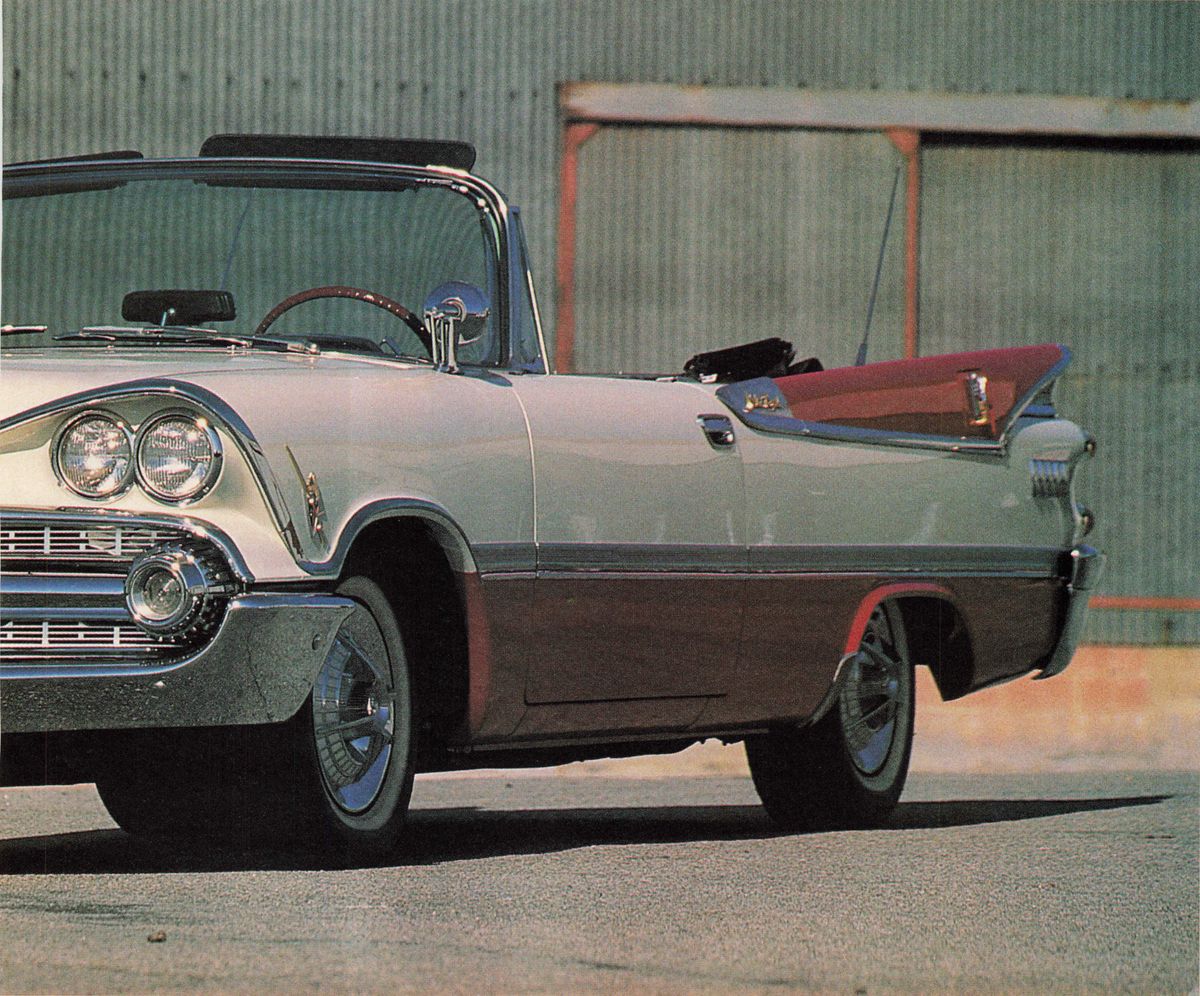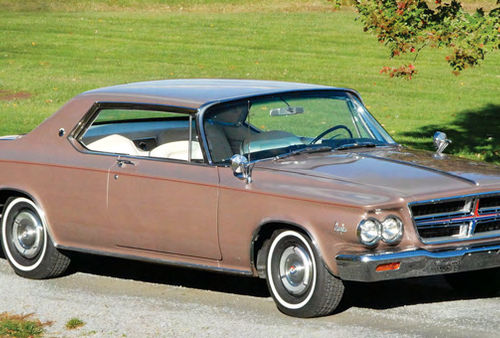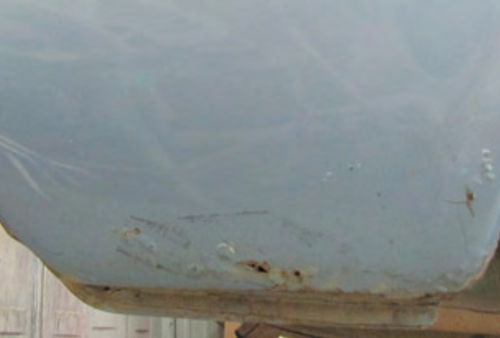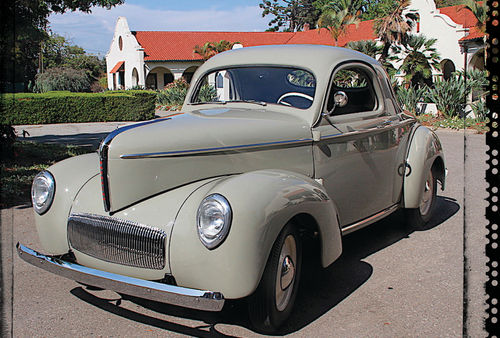1959 Dodge Custom Royal Lancer
No one would dispute that the second half of the 1950s was a time of practically uncompromised flamboyance in terms of automotive design. Who was the most outrageous? If it were put to a vote, it would be a safe bet that Chrysler Corp. cars would gain a great deal of attention.
If the Mopars couldn't win this election, it wouldn't be because they displayed anything close to restraint in their styling efforts. With Virgil Exner's designs pushing the parameters of longer, lower and wider and causing other manufacturers to react in kind, there was a war being waged to see which company could out-fin the others. What started as a little bump on the 1947 Cadillac grew into a design element that nearly became wings for flightless vehicles. Talk about a flight of fancy. Chrysler was flying high.
The Space Age had much to do with it. The United States was embroiled in a space race with Russia and the excitement of this competition had captured the attention of this nation. Everyone, including automotive designers, looked skyward for ideas to fuel their optimism. The future held great promise that man’s mastery over machines had us on the verge of utopia. Expectations developed that space travel was within the grasp of the next generation. Automobiles of that time were rocketing into their own version of space-age travel that could be simulated on the superhighways. The automobiles were ready to take people places they had never been before.
The Dodge Custom Royal Lancer convertible for 1959 can be seen as an emblematic creation of that era.
The entire line of Chrysler automobiles from 1955 to 1959 demonstrate, in a variety of ways, the influences of aviation, space travel and the promises of push-button conveniences were instilled in the common vision of the future. Perhaps more than any other manufacturer, Chrysler was pushing the limits of performance, engineering and design. Just because America’s primary mode of transportation was grounded didn’t mean that designs couldn’t be pointed toward the heavens.
Exner creations for Chrysler greatly expanded the use of glass in the overall design and corporate sales literature promoted what was termed the “New Horizon” windshield that created a “glass cockpit” for the driver and passengers. Controls for the car and its ever-increasing number of accessories were now referred to as “flight styled” instruments and included the “Flite Control” automatic transmission selector lever on the dash board. On Dodges and DeSotos the taillights were stacked in jet fuselage fashion. Longer and lower bodies were not only accentuated by the use of glass all around, but two- and three-tone paint schemes added to the feeling that cars were increasingly becoming a fashionable item. A new level of youthfulness was driving the business of selling cars. Chrysler called it “The Forward Look.”
The 1959 Dodge Custom Royal stands out in any crowd. In typical late 50s fashion it was created with an obvious emphasis on performance and style. In many ways it was an exaggerated version of the previous Dodge models that had proved successful in the boom years (the time frame in which the 1959 model was conceived). It also has been labeled as the poor man’s Chrysler 300. In 1959, the base price for a Chrysler 300 convertible was about $5750, while a base Dodge Custom Royal convertible would weigh in at about $3370.
Dodge offered a variety of powerful V-8 engines to power their star fleet in 59: the 255 horsepower Red Ram was a 326-cubic-inch powerplant; the Ram Fire V-8 stepped up to 361 cubic inches and produced 295 horses: the D500: flexed 520 horsepower from its 383-cubic-inch block when coupled with a single four-barrel carburetor and 345 horsepower when the dual four-barrel setup was added; fuel-injected versions of the D500 engine were called Super D500s and were also capable of putting the driver at the reins of 345 horsepower. That provided plenty of power to haul your buns to the bakery, yet it was still 35 horsepower shy of the monster Chrysler 300E.

The instrument panel of the Custom Royal has the look of a 1950s science fiction movie. Creativity was unhampered by tradition and designers presented the controls of a spaceship from the movie set of “Forbidden Planet.”
Chrysler’s three-speed TorqueFlite automatic transmission was standard on the Custom Royals. The push-button selector is mounted on a pod to the deft of the steering wheel to keep it a safe distance from the curious or careless passenger. Selector buttons were marked first, second, drive and reverse. Curiously there was no park selection on the TorqueFlite. Chrysier claimed its excellent parking brake rendered such a feature useless.
The temperature, fuel, oil pressure and ammeter gauges are clustered on two additional pods that flank the clock directly behind the steering wheel. To the left of the Wheel are the wiper and light switches and to the right are the cigarette lighter and the ignition switch. The speedometer is a horizontal, ribbon-type that changes color as the speed of the car increases: below 30 mph, the ribbon is. green; from 30 to 50; it 1s amber; and at speeds in excess of 50 mph the band becomes red.
Optional equipment, with an emphasis on the much-publicized convenience factor, included a transistorized AM radio (the first year Chrysler went tubeless), power windows, backup lights, dual rear antennas, six-way power seats, swivel bucket seats, and a remote control outside rearview mirror for the driver. Decidedly high-tech for 1959 was the “Mirror Matic” rearview mirror that would automatically change to night setting when the photo cell in the mirror was struck by the headlights of a trailing car and the automatic beam-changer that would dim the bright lights when an on-coming car approached.
Custom Royal Lancer models were the most expensive cars Dodge offered from 1955 to 1959.
This has created some confusion, because Custom Royals such as our 59 feature car made use of the Lancer badge (a knight’s helmet, sometimes above a shield with a long lance) on the front fenders, wheel covers, rear deck lid and gas cap door, but carried no Lancer nameplate. To further cloud the issue, certain Dodge Coronet hardtops and convertibles were identified as Lancers in the sales literature, but did not display any Lancer badges or nameplates.
The Coronets were the least expensive Dodge models in the lineup for 1959. Next came the Royal series, the Sierra station wagons, and the top-of-the-line Custom Royal series. Factory-suggested prices began at $2466 and topped out at $3389.
Dodge sales reflected the overall success of the auto industry from 1955 to 1957, but fell dramatically in 1958. In 1959 sales inched upward, but a new era of automobile design was being ushered in by the likes of small cars such as Corvair, Falcon and most importantly, Volkswagen. Styling treatments such as the dual headlights recessed under chrome trimmed “eyebrows,” tail fins and “grille bombs” were on their way out.

While the 1959 Cadillac will forever be considered the icon of 50s automotive imagination and creativity, the Dodge Custom Royal shouldn’t be overlooked. Its flair and unique interpretation of space-age design and high performance are unique and well worth the admiration of hobbyists and historians. # Chrysler’s 383 V-8 — the long-time street racer’s friend.
Chrysler's 383 V-8 the long-time street racer's friend.
One of the best known engines of the musclecar era was Chrysler’s venerable 383. Since its debut in the 1959 Dodge Custom Royal Super D-500, nearly a dozen slightly different variations of the 383 were seen and heard on the streets. During the height of musclecar mania, this powerplant would be the mainstay for Mopar street beasts such as Road Runners, Barracudas, Challengers, Coronets and even Darts.
The 383 was a 90-degree V-8 with hydraulic valve lifters, five main bearings, a 10:1 compression ratio and a 4.25 x 3.38 bore and stroke. Carburetion and cam duration changes would be the primary alterations over the years until the engine went out of production in 1971.
In its introductory year, the engine could be ordered with twin Carter four-barrel carburetors that pumped the standard engine (rated at 320 horsepower) to nearly the peak of the 1959 horsepower mountain. Even with a robust 345 horses, the Dodge was short of the industry-leading Chrysler 300 by 35 ponies. There were more mountains to climb in 1960 when the Ram Induction 383 high-performance engine erupted for 425 horsepower. However, most 383s did not come from the factory breathing this kind of fire.
All things considered, the 383 was one of the most powerful stock engines built in the late 50s and early 60s. Its reputation was often unfairly diminished because Chrysler made more noise with its Hemi-powered racers. Very few Hemis were on the streets though and that is where the 383 was left to defend the company’s honor. With this task it performed quite admirably.
One of the most memorable Mopars to be powered by the 383 was the new 1966 Dodge Charger: a formidable street racing machine. Straight from the factory and with an automatic transmission, this car could do 0-60 in nine seconds and reach a top speed of 110 mph. With the four-barrel Carter carburetor, it delivered 325 horsepower. In 1970, Dodge delivered a Charger R/T Scat Pack with a 335 horsepower version of the 383. This same configuration was standard equipment in the Coronet Super Bee of that year. The biggest surprise from the rapid transit people came when they dropped the 383 into the lightweight Dodge Dart GTS as an answer to the Chevy Nova SS. It was a rare combination, but one that was to be reckoned with on the street scene. Mark LaPoint, an engine specialist with Mopar Performance — a racing division of Chrysler — owns a GTS, but claims the 383 was a better mate to the Challengers and ’Cudas. Cars with the heavy-duty suspension options (Road Runners included) had a better setup for keeping the powerful 383s pointed in the right direction. “These engines were very strong and solid,” LaPoint says. They did very well against competitors. A 396 Chevy Chevelle had a hard time beating a Road Runner because the 383 was designed to torque bigger cars to go faster.”
These restorers have a never-ending quest for fins.
Bo Malefors specializes in restoring the flamboyant winged wonders of the Chrysler Corporation’s Exner years. When he found a 1959 Dodge Custom Royal convertible peeking out from under a tarp behind an Oregon house in 1991, he knew this Mopar needed a loving home.
Not quite a basket case, it still was in need of considerable work. The convertible top was thrashed and the interior was torn to pieces. On the bright side, the body was in great shape.
Malefors wanted the car, but the owner was less than willing to sell. She chased Malefors away. Later when he learned the owner needed money for the upkeep of a beloved 1966 Cessna airplane, a deal was struck.
At this point Aivar Lejins of Monrovia, California, enters the picture. Lejins has an uncontrollable fascination with the flashy styling and high performance of late 1950s Mopars. He has owned dozens of Dodges, DeSotos, Chryslers and Plymouths from this era. When Malefors told Lejins what he had, it was only a matter of time, and not very much time, before Lejins owned the car.
Lejins began to have the car restored but was unhappy with the progress and in mid-restoration shipped the car in boxes to Malefors. Working on a project that was started by someone else always seems to make it more difficult, but that’s the way this project was laid before him.
In the process an NOS windshield and NOS front and rear seats were installed. A black Hartz canvas top was made to replace the tattered remains of the original. The trunk floor and several sections of floor inside the passenger area were replaced with fresh sheetmetal and the trunk lid was replaced with the lid from a parts car. Most everything else was restored from original parts.

One alteration that was made involved the original D-500 engine that was upgraded to Super D-500 specifications. According to the restorer, the basic change is the conversion from a single four-barrel carburetor to a dual four-barrel set up. Among the associated changes are alteration in the intake and exhaust manifolds, the carburetor linkage, the camshaft and the distributor. Over the course of 20 months the Custom Royal convertible was brought back to life.
Dodge produced only 984 Custom Royal convertibles in 1959. Only a fraction of those were Super D-500s. Perhaps a dozen survive today according to Malefors. “These cars need to be preserved,” says Lejins as he affectionately runs his hand along the tail fin. “I wouldn’t want to see this junked or end up in the wrong hands. I feel I should restore these babies for the future.”
















